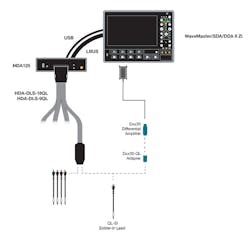While it’s definitely nice that the new HDA125 digital analyzer from Teledyne LeCroy zips along at 12.5 GSamples/s on 18 input channels, a closer look shows that the story is more about addressing real-world embedded test and validation problems in the most practical and cost-effective manner possible.
Of course, that’s what all test vendors strive to accomplish. Nothing strange there, so you’d be forgiven for moving along at this point, but hang on a second. Yes, the sampling rate is high, and note too that the HDA125 is an external box that connects to any Teledyne LeCroy scope via the proprietary LBUS interface to synch triggers and timebases to the picosecond (Fig. 1).
1. The HDA125 is a high-speed mixed-signal analyzer and probe system that operates as an add-on to the Teledyne LeCroy WaveMaster line of scopes so you can get the functionality without buying a whole new mixed-signal oscilloscope.
That approach is also what grabbed my attention: modular is smart as it leverages the installed base of oscilloscopes to cater to current users’ needs, and helps keep costs down and provides flexibility. The system would typically be matched to one of the company’s WaveMaster 4- to 30-GHz scopes.
Then I noticed that the HDA125 itself costs up to $20,000 if you ordered a full, 18-channel leadset. That’s when I realized there was much more to the HDA125 than appeared at first blush.
Obviously, going from a regular DSO to an MSO has a cost differential associated with it. According to Teledyne LeCroy’s Patrick Connally, technical marketing engineer for high-bandwidth oscilloscopes, the cost differential is in the same ballpark as the cost of the full HDA125, “except you don’t get the lead set: and that’s a pretty high-tech piece of equipment.” He added that with competitors’ standalone MSOs, “that can be an extra $7,500 to get the bandwidth needed for [the high-speed] sample rate to be useful.”
The HDA125 is all about being useful, hence the addition of features such as the QuickLink probe tip system for the leadsets, and a 150-mV voltage-swing sensitivity. The QuickLink probes can be soldered to the points of interest and then the high-fidelity “flying lead” connectors that work with the HDA125 and WaveLink probes using the new Dxx30-QL QuickLink adapter (Fig. 2).
2. The HDA125âs QuickLink cross-connection probing system lets you test specific nodes repeatedly without damaging the joints, while also letting you swap between analog and digital signal acquisition as needed.
This approach gets around the problem of repeatedly probing a single test node and potentially straining or otherwise damaging the integrity of the solder joint. Instead, either digital or analog probes can be easily attached or swapped as needed.
Along with enabling 150-mV sensitivity, the HDA125 leadset has 9 or 18 differential channels, a bandwidth of 3 GHz, and minimizes loading through the use of a high-input-impedance of 110 kΩ at 0.12pF, differential.
Overcoming Challenges
While the HDA125 has many features, it’s the ability to examine both command line and data line signals in real time—simultaneously—that really makes it useful, especially for high-speed embedded systems using DDR memory.
As Connally points out, DDR is notoriously difficult to integrate, validate, and debug. The issue was that for a long time the only tools available were for testing for JEDEC compliance, “which is interesting if you're making DDR and DRAM controller chips and you have to prove compliance, but a lot of people are simply buying these devices, integrating them, and then trying to find out if they work, how well they work, and if they don't work, how to debug them.”
In the case of DDR, there are read and write bursts happening at the same time in opposite directions, making it really hard to differentiate “1s” from “0s”. Usually a skew-detection algorithm helps you see the read and write data separately, but it gets more difficult to figure out the right algorithm as DDR speeds increase.
Using the Teledyne LeCroy DDR Debug Toolkit, the HDA125 allows you to view both the command line and the data lines at the same time, so it literally tells you which data is read and which is write by correlating the command to the pin signal. “There’s no more trying to figure it out,” says Connally. “You have a completely deterministic way of separating read and write busts—and on top of that, you can look at an entire record [over time].”
These are just a smattering of the features that make the HDA125 particularly useful and what make it stand out from the pack. That said, it’s still a high-end piece of equipment, with the price tag to match.
The system is available within six to eight weeks after receipt of order and in two models. The HAD125-18-LBUs comes with a full 18-channel leadset (including 18 QL-SI probe tips), and is priced at $20,900. The HDA125-09-LBUS has a 9-channel leadset (including 9 QL-SI probe tips), and is priced at $17,900. The HDA125 will initially be compatible with WaveMaster, SDA, and DDA 8Zi series oscilloscopes; compatibility with other instruments will follow.
The Dxx30-QL connects QL-SI probe tips to Dxx30 8-13 GHz WaveLink differential probe series and is priced at $850. A QuickLink “starter pack,” the Dxx30-QL-3SI, is priced at $1,390 and consists of one Dxx30-QL adapter and three QL-SI tips. Support for the QL-SI tip on 4-6 GHz WaveLink differential probes will be added in the spring of 2016.


